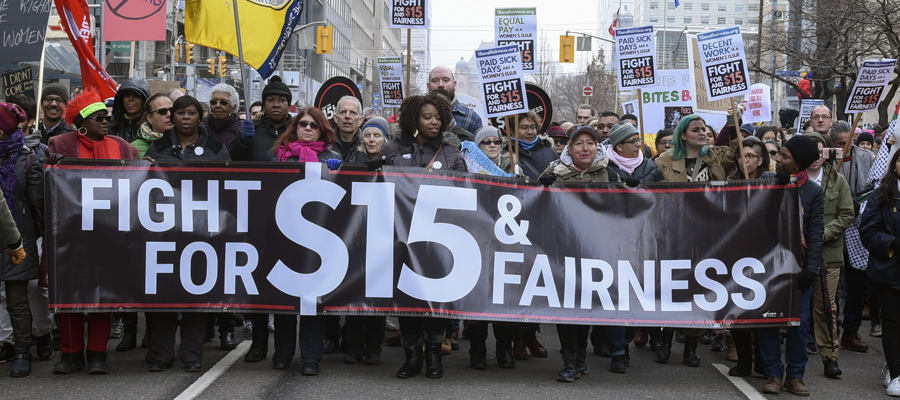Raising the minimum wage is good for public health

Soon we expect the Fair Wages Commission to advise the BC government on a path towards a $15 minimum wage and a plan for regular increases. This will be very good news for our province. Increasing the minimum wage is an important step in reducing poverty and income inequalities that cause poor health. In charting a path towards a $15 minimum wage and beyond, it is important that we adopt a health equity perspective and consider the minimum wage increase a matter of public health that can reduce health inequalities and free up public health care dollars for existing and new services.
Minimum wages and public health: What the evidence tells us
BC’s current minimum wage is a poverty-level wage. Over 400,000 British Columbians work for less than $15 per hour—or 22 per cent of all paid employees in the province. The majority of these workers are women (59 per cent) aged 20 years old and over (78 per cent) and work full-time (54 per cent).1 Most are full-time adult workers and are likely to experience poor health based on their low income status. There is no question that BC’s current minimum wage contributes to BC’s high poverty rate of 14.8 per cent in 2015—the highest in Canada.2 Although we live in a wealthy province, BC leads the country in working poverty.3
Income is the most important ‘upstream’ determinant of health. People with lower incomes have less favourable health outcomes, higher rates of chronic disease and lower life expectancies.4 For working-age adults and their families in BC, employment income largely determines whether households can avoid poverty and attain the conditions necessary to avoid poor health. These conditions are referred to as the social (or socio-economic) determinants of health, and include unemployment and underemployment, working and housing conditions and access to essential goods and services (e.g. food, health care, housing and transportation).5 Put simply, the higher your socio-economic position, the better your health based on your material circumstances and the goods and services you can access.6
The differences in health outcomes that exist between socio-economic classes are referred to as health inequalities. A direct relationship exists between rising income inequalities and inequalities in health across a given population.7 In a research report, the Provincial Health Services Authority—one of the BC’s health authorities confirmed that low-income British Columbians are at greater a risk factor of chronic disease and are more likely to suffer from diabetes, heart disease, anxiety and depression than people with higher incomes.8
Income is the most important ‘upstream’ determinant of health. People with lower incomes have less favourable health outcomes, higher rates of chronic disease and lower life expectancies.
Yet health inequalities in BC are widening. The Health Officers Council of BC—an organization made up of public health physicians—has published comprehensive research on the topic. In 2008, the Council found that “there is a relatively large number of disadvantaged people in the province—the unemployed and working poor [and] children and families living in poverty … all of whom experience significantly lower levels of health than the average British Columbian.”9 In their 2013 update, the Health Officers Council concluded that the substantial differences in life expectancies between the wealthiest and poorest segments of the population had increased—a trend that demonstrates that the health gap between higher and lower income groups is widening in BC.10
From decades of research, we have learned that the determinants of health and health inequalities are most effectively addressed with upstream public policy interventions that focus on reducing poverty and income inequality, including labour market and minimum wage policies. In the words of leading public health professor Clare Bambra,
“patterns of health and disease are produced by the structures, values and priorities of political and economic systems. Area-level health—be it local, regional or national—is determined (at least in part) by the wider political, social and economic system and the actions of the government … and whether there are collective interventions to improve health and reduce health inequalities.”11
The CCPA-BC has long called for the minimum wage to be used as a tool to reduce poverty and income inequality—in David Green’s research brief and, most recently, in the CCPA-BC’s submission to the Fair Wages Commission. From a public health perspective, provincial, national and international health organizations have recommended using the minimum wage to reduce income and health inequalities:
- Over 400 organizations, representing hundreds of thousands of British Columbians, signed the BC Poverty Reduction Coalition’s call for a provincial poverty reduction plan, with a $15 an hour minimum wage as a necessary step in increasing incomes and health equity.
- The Health Officers Council of BC recommended that “the minimum wage reflect a ‘living wage’ in order to eliminate the situation faced by the working poor—people working full-time but still facing poverty.”12
- In a 2015 report, the Canadian Institute for Health Information (CIHI) identified labour market policies, including the minimum wage, as a key poverty reduction measure that will reduce income and health inequalities.13
- In 2008, the World Health Organization (WHO) released its landmark report, Closing the Gap in a Generation: Health Equity Through Action on the Social Determinants of Health. Among its many recommendations, it concluded that “minimum wages should … be sufficient for healthy living.”14 In 2011, the Government of Canada committed to implement the WHO Rio Political Declaration on Social Determinants of Health and take measurable action in reducing health inequalities.
Low wages and poverty are costly to the public purse
There is also another important benefit to using the minimum wage to reduce health inequalities: it can eliminate avoidable costs to the public health care system that result from chronic disease and use of hospitals, emergency rooms and prescription drugs.
The exact cost-savings associated with increasing BC’s minimum wage are difficult to estimate. However, increasing the minimum wage is a necessary step in boosting incomes for low-income households and reducing avoidable health care costs associated with poverty and inequality. For example, a Saskatchewan study found that low-income residents’ health care costs were 35 per cent higher than middle- and higher-income groups, amounting to $179 million in annual savings to the provincial government if low-income residents had the same health care costs as middle-income residents.15 Estimates suggest that 20 per cent of total health care spending is attributable to inequalities.16 Based on this approximation, in 2008 the Health Officers Council estimated that public spending attributed to inequalities amounted to $2.6 billion annually. Updating this estimate based on what the province spent on health care in 2016/17, the potential cost-savings rise to $3.9 billion if health inequalities were eliminated.17
Increasing the minimum wage is a necessary step in reducing avoidable health care costs associated with poverty and inequality.
While a $15 minimum wage would bring full-time workers slightly above the poverty line, it will not fully eliminate inequalities in health outcomes for households at the bottom of the income distribution. This will require further action to boost incomes and reduce inequality through a comprehensive poverty reduction plan, improving tax fairness, increasing welfare and disability rates, upstream investments in universal early childhood education and public policies that recognize and support the role of labour unions in promoting public health. It will be a big step forward if the Fair Wages Commission charts a path to transition the minimum wage to a Living Wage, in an effort to move toward what public health experts refer to as the “minimum income for healthy living.” For too long, billions of dollars have been spent on the downstream consequences of a minimum wage that keeps full-time workers in poverty and suffering from poor physical and mental health. A speedy increase to a $15 minimum wage and plan for predictable increases can’t come soon enough.
$15 minimum wage: A prescription for health equity and public savings
Low wages are a big part of the poverty and health inequality story in BC. But it is not only low-income British Columbians who will benefit from an increase in the minimum wage. All members of society—including middle-income and wealthy households—benefit from greater equality.18 Perhaps the biggest takeaway from decades of inequality research is that more equal societies are generally healthier and happier—or what is referred to as the equality effect.
By reducing health inequalities that are costly to government and have a corrosive effect on society, a $15 minimum wage and progress towards the Living Wage must be seen for what it is—a prescription for health equity and smart management of public finances.
Notes
- Statistics Canada, Labour Force Survey Public Use Microdata Files for 2016. Prepared by Iglika Ivanova, Canadian Centre for Policy Alternatives—BC Office.
- Seth Klein et al. (2017), Long Overdue: Why BC Needs a Poverty Reduction Plan. Canadian Centre for Policy Alternatives—BC Office.
- Iglika Ivanova (2016), Working Poverty in Metro Vancouver. Vancouver: Canadian Centre for Policy Alternatives—BC Office, p. 14.
- Commission on Social Determinants of Health (2008), Closing the gap in a generation: health equity through action on the social determinants of health. Final Report of the Commission on Social Determinants of Health. Geneva: World Health Organization; Danny Dorling (2013), Unequal health: the scandal of our times, Bristol: Policy Press; Michael Marmot (2015), The Health Gap: The Challenge of an Unequal World, New York: Bloomsbury Press; Clare Bambra (2016), Health Divides: Where You Live Can Kill You, Bristol: Policy Press.
- Clare Bambra (2011), Work, Worklessness and the Political Economy of Health. Oxford: Oxford University Press, p. 9.
- Bambra 2011, p. 12.
- Bambra 2011, p. 12. Health inequalities refer to observed differences in health by population groups (e.g. income), while health inequities refer to differences that are unfair or unjust. Measuring health inequalities, as the Canadian Institute for Health Information notes, is important in order to identify and reduce health inequities.
- Provincial Health Services Authority (2011), Towards Reducing Health Inequities: A Health System Approach to Chronic Disease Prevention. A Discussion Paper, Vancouver, BC: Population & Public Health, Provincial Health Services Authority, p. 19.
- Health Officers Council of BC (2008), Health Inequities in British Columbia: Discussion Paper, p. 8.
- Health Officers Council of BC (2013), Health Inequities in BC, p. 12.
- Bambra 2016, p. 139.
- Health Officers Council of BC 2008, p. 11.
- Canadian Institute for Health Information (2015), Trends in Income-Related Health Inequalities in Canada. Technical report. Revised July 2016, p. 37.
- Commission on Social Determinants of Health 2008, p. 90.
- Public Health Agency of Canada (2016), The Direct Economic Burden of Socio-Economic Health Inequalities in Canada, p. 5.
- Public Health Agency of Canada 2016, p. 5.
- Health Officers Council of BC 2008, p. 49.
- Richard Wilkinson and Kate Pickett (2009), The Spirit Level: Why More Equal Societies Almost Always Do Better. London: Penguin; Danny Dorling (2017), The equality effect: improving life for everyone, Oxford: New Internationalist.
Topics: Employment & labour, Health care, Poverty, inequality & welfare


